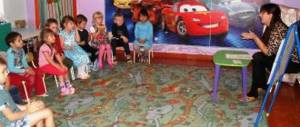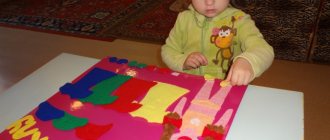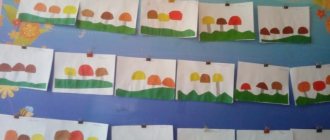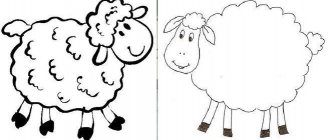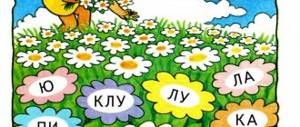Preparatory stage
Children with great pleasure get acquainted with water modes of transport in the form of a game or doing an applique.
The main stage of a kindergarten teacher’s work is to prepare an interesting lesson scenario. And if we talk about the application, the success of the entire work will depend not only on the accuracy of the application, but also on the competent preliminary activity of the adult.
Materials
Children in the middle group - 3-4 years old - can work not only with paper and plasticine. For creativity, you can use natural materials (for example, make boats from dry leaves), thick paper (for example, velvet colored paper for boats or as a basis for simulating water). Some experienced methodologists believe that in the middle group it is possible to use fabric as a raw material for appliqué. The fact is that, despite all the “capriciousness” of the material, children can work with it at the level of tactile memory: when parents gave different textures to the little one’s hands to develop motor skills. True, it is worth noting that fabric elements should be given to the children as a finished part, so that they do not need to cut them or process the edges (by the way, even in the older group, the fabric is introduced into the work only partially and also in the form of a finished part of the applique, which remains only stick).
Children's participation in preparatory work
Children of the middle group can independently prepare their workplaces, laying out the necessary materials and tools
This is interesting. Scientists involved in child psychology consider the 3-year-old crisis to be one of the most difficult transitional stages in a person’s life. This is the age when a child first encounters such a gap between what he wants to do and what he can do - such a discrepancy is painfully experienced by the psyche of a child who is not yet accustomed to putting up with circumstances. But on the other hand, the little ones begin to understand the authority of an adult (“He can do anything!”). They want to be like him, and therefore perform a number of functions of an older comrade (wipe dishes, wash the floor, etc.). It is this feature that can be used when connecting kids to organizing workspaces for appliqué work.
So guys can
- lay out tools on tables;
- distribute the blanks for applique (base, rectangles for boats);
- prepare napkins for working with glue.
Separately, it is worth mentioning about cutting blanks. For this craft, you only need rectangles, from which the children will cut out boats. Such quadrangles can be made by adults, but if there are diligent, focused children in the group, then cutting sheets of paper into rectangles can be entrusted to them. Also in favor of the children's greater independence is the fact that they are already well versed in elementary geometric shapes and distinguish them by shape.
Execution options
As for technology, the choice here is not very diverse. This state of affairs is explained by the fact that children do not yet have much experience in creating crafts.
- Classic. Gluing paper parts onto a paper base is the most accessible type of applique for kids.
- Finishing the drawing. Adding drawn details to the composition (for example, the surface of a river) will add originality to the work.
- Coloring. To complicate the task of appliqué, you can make all the details from white paper and then paint them.
- Plasticine. As in the case of ordinary paper, children are very familiar with activities with plasticine. Moreover, the details turn out to be textured, that is, children learn to create three-dimensional paintings.
- Corrugated paper. The use of this material is not considered too difficult. In addition, it sticks quickly, which cannot but please impatient “creators”. An important nuance: you should not trust toddlers to smear corrugated paper with glue, as it will quickly get wet due to excess. It is better to leave this mission for yourself.
- Mosaic. Children love to work with cereals, but it is better to do this under the supervision of an adult, as the material may end up in the child’s mouth. So this technique can only be used if there are few people in the group, and the children are close to 4 years old.
How to implement a personal approach
The rhetorical question of the entire educational system did not bypass a special case: preparing a lesson on application in the middle group. To individualize the implementation of a group craft, children need to be offered tasks based on their temperament and abilities . Of course, children who are ahead of their peers in intellectual development are capable of preparing for work, gluing complex elements, and decorating the background. But since there are only a few such guys, it is better to focus on temperament. Thus, fidgets can create a composition dry, and those who have a more restrained disposition will do an excellent job of gluing these parts or decorating the boat with decorative elements, such as, for example, beads, rhinestones, etc.
How to motivate
Kids enjoy listening to stories about dolls or animals that came to them from a fairyland, and are very willing to take on crafts designed to help guests in trouble.
The right motivation will help you successfully complete the application within the time allotted for the lesson. You can use one technique, or you can combine them depending on the ability to work and the degree of involvement of the children in work.
Conversation
You can start the lesson with questions about what types of transport the children know, but, given the age of the students, it is better if this is a conversation on behalf of a fairy-tale character. For example, on behalf of the doll Masha, whose house is located far away, across the river. And to get across the pond she had to use transport. Which one? After answering the question, the teacher shows the kids pictures of boats and other types of water transport (yacht, steamship, ferry, ship). This beginning is a good way to create the applique itself: the guys need to make boats so that Masha and her new friends can return home.
Poems
Children really like rhyming lines, so this kind of motivation also has a place. However, the teacher will still need to use questions to lead the kids to the essence of the lesson.
- In the hot summer it’s boring to stay at home... We’ll go in a boat for a ride along the river!
- One-two, got it! One-two, together! Let's push the boat into the water. We'll take the oars in our hands and go fishing.
More poems about the boat can be found here Error:
">https://www.numama.ru/blogs/kopilka-detskih-stihov/stihi-pro-lodku.html">https://www.numama.ru/blogs/kopilka-detskih-stihov/stihi-pro -lodku.html
Songs
Kids perceive rhythm and melody well, so songs are a technique that not only puts them in a working mood, but also gives them a good mood. As an example, we can suggest https://yandex.ua/video/search?text=songs%20about%20boat%20for%20children&path=wizard&parent-reqid=1481839276798259–1816341218547199392616902-myt1–0790&noreask=1&filmId=17838 796170432786074 Moreover, it’s not easy song, but a whole short educational cartoon.
Visibility
Children think in pictures, so pictures are indispensable when using any motivational techniques. These can be images on paper or slides on a presentation. Try to select images of several types of boats, as well as 2-3 other types of water transport.
How to work on class notes
When compiling a lesson plan for an application, you need to plan the time required to complete a particular task so that the children complete the tasks on time
Developing a lesson plan begins with formulating the goals and objectives of the work. An applique lesson in the middle group on the topic: “Boats float on the river” has goals
- teach children to create parts by cutting off the corners of rectangular blanks (if the composition is made of paper);
- develop the ability to compose a composition according to a model, as well as carefully paste its elements (regardless of the execution technique);
- nurturing taste and sense of proportion when combining parts into one whole.
The tasks can be formulated as follows
- expand children’s understanding of color standards, size (width-length);
- develop the ability to compare details according to these characteristics, classify and generalize;
- continue to work on speech development (all comments during the work should be given by children in complete sentences);
- train your eye;
- teach the skills of independently searching for a given task;
- develop skills of self-esteem and self-control.
The outline diagram can be presented like this
- motivation;
- main part;
- reflection.
Sample abstract
Lagutkina Nadezhda, Lesson notes (application) in the middle group “Boats float on the river”
| There is a bell in the hands of the teacher. -The bell sings, calling all the guys to the circle! Show me your palms, I will stroke them a little. and you look at each other and give a smile! Let's smile and give each other a good mood! (The song is played from the cartoon “Leopold the Cat”) - Guys, who do you think sings this song (What do you think, Sasha?) Slide 1. - Today Leopold the cat came to visit us! Let's say hello to him! -Guys, Leopold the cat was invited to visit the little mice, but they live far away. There is a big river where they live. Slide 2. -What do you think Leopold the cat can use to cross the river and visit the mice (children's answers: ship, sailboat, motor boat, boat) Slide 3 -Shall we help Leopold the cat visit the mice? Listen to the poem and think about what we will send Leopold the cat on. -It’s boring to stay at home in the hot summer. We'll go in a boat for a ride on the river! (children's answers in full sentences) Slide 4 - Guys, today we will make beautiful boats. Look at this rectangle in my hands, what do you think needs to be done to make a boat? (cut corners with scissors) - In which hand will we hold the scissors? (And what does Olya think? open them wide (the teacher shows) - And what will the left hand do (children's answers in full sentences) - Look how I will do it. (showing) - What needs to be done with the boat after cutting the corners (Children's answers) - Guys we take a boat. We put it on a napkin with the colored side down and carefully spread it with glue. Then we take it and carefully glue it onto a blue background. - Why do you think it’s on a blue background (children’s answers) - To hold the scissors well, you need to stretch your fingers. . Let’s play playing a game with fingers. One, two, three, four, five - We will collect leaves. They clench and unclench their fists. Birch leaves, Bend the thumb. Rowan leaves, Bend the index finger. Poplar leaves, Bend the middle finger. Aspen leaves, Bend the ring finger finger. We will collect oak leaves, Bend the little finger. We'll take an autumn bouquet to mom. They clench and unclench their fists. Slide 5 - Go behind your workstations and start working. We don’t bend over at the table, we keep our back straight (I remind you of the technique of working with scissors) Physical education One, two, three, four, five! Let's jump and jump! (Jumping in place.) The right side bent. (Tilts the body left and right) One, two, three. Left side bent. One two Three. Now let’s raise our hands (Hands up.) And reach for the cloud. Let's sit on the path, (Sit down on the floor.) We'll stretch our legs. Let's bend our right leg, (Bend our legs at the knee.) One, two, three! Let's bend the left leg, One, two, three. They raised their hands high (Raised their hands up.) And held it for a while. They shook their heads (Move their heads.) And everyone stood up together. (Stand up.) -Guys, take your work and stand in a circle. -The mouse guys found out that you helped the cat Leopold and made a lot of boats, they were happy, climbed high into a tree and were waiting for him. Slide 6. Reflection. -Do you think the cat Leopold liked your boats (children's answers) -What did you learn today? -What did you like about the lesson? – Who found it difficult? |
Summary "Boats float on the river"
Ortangs to be used
Summary of organized educational activities in the middle group
About the event/Date:
Tarbieshi/Teacher:
Bilim take salas/Educational area:
creation
Pәn/Item:
applique
Ө tpeli takyryp/Cross-cutting theme:
The world around us
Takyryby/Topic:
“Cut and paste what kind of building you want” (as planned)
Maksattaras/Goals:
1.Tarbielik - educational
: Cultivate interest in the lesson
.
2. Damytushylyk developing:
Forming in children the ability to create a variety of images of buildings in applications.
3.Okytu-training:
Continue to practice cutting strips in a straight line, squares diagonally, etc. Learn to think through the selection of parts according to shape and color.
Pedagogical technology / pedagogical technology:
gaming, health-saving
Resurstarmen kamtamasyz etu/Resource support:
Designer parts (wooden and plastic, different shapes: cubes, bricks, triangular prisms). Strips of paper of different colors measuring 3x8 cm, square sheets of paper 16x16 cm, scissors, glue, glue brush, napkin, oilcloth (for each child). Wonderful bag, construction set details (cube, brick, triangular prism).
Bilingualdyk component. Bilingual component:
Ұ yimdastyrylgan қу қызмінін Barysy
1. yimdastyrushylyk kezeni/organizational moment
Game situation: I’m a wonderful little bag to all the guys, I’m a friend, I really want to know what you like to play with. Guys, do you want to know what is hidden in the wonderful bag?
— Problem situation: the guys take out the parts of the construction set from the bag.
+What is this? (constructor details)
2.
Negіzi bolіmі/main part
: examination of details, clarification of the shape and color of parts (cube, brick, triangular prism).
What can be built from these parts (gate, house, garage, bridge, arch).
Invite several children to build various buildings. (While the children are building, clarify what parts are used for construction).
Consider and clarify with children what geometric shapes are the basis of the construction set parts (cube - square, brick - rectangle, trihedral prism - triangle).
— Fizkul
— Draw the children’s attention to the strips of paper lying on the tables.
What color are they.
Is it possible to make a building out of these strips?
- Lead them to the fact that the strips must be cut to obtain the necessary parts.
How should the strip be cut to obtain the desired shape? (If the children miss something, remind them how to cut the strip)
— . Invite the children to think about what kind of building they would like to create and what parts they need for this.
— Offer to think about what colors look beautiful in combination and choose them for appliqué.
— Finger gymnastics “Home”
There is a house in a clearing, (Draw the house with two hands, the roof of the house - the fingers of the left and right hands are touching each other. But the path to the house is closed. (The right and left hands are turned with palms towards themselves, the middle fingers are in contact with each other, the thumbs fingers up (“gate”) We open the gate, (Palms turn parallel to each other) We invite you to this house.
— Invite the children to start working, cut out and paste a beautiful building, whatever they want.
— Independent work of children (I supervise work with scissors)
3. Results /final part
— At the end of the lesson, admire the works. The children tell us what they did. Choose the most interesting buildings.
What did we do today?
Was it difficult to make the buildings?
What will you tell your parents at home?
Schemes for working on the application “Boats float on the river” in the middle group
Let's look at three step-by-step explanations of how to perform the “Boats Float on the River” appliqué.
Option #1
For this application, the background is created by the teacher
This is a collective application. Children make paper boats on a white backing and then glue them onto the “river”.
Instructions:
- Making the base of the boat. “Guys, let’s do it like I do. Take a cherry-colored rectangle and cut off the corners on the long side.”
- Cut out the mast. “Now we cut the purple rectangle diagonally like I did.”
- Place the parts on the backing.
- Glue it.
- We place the substrates against a common background - a river drawn on several glued A4 sheets.
Option No. 2
Despite the fact that this mosaic applique is an individual work, the materials can be shared by 3-4 children
This is a mosaic application.
Instructions:
- The teacher gives the children sheets of blue paper (preferably thin cardboard) with the outlines of a boat drawn on them.
- “Guys, coat the base of the boat with glue and carefully sprinkle it with millet.”
- Repeat the previous step with the mast.
- Let the application dry.
Option #3
The base of this boat is made by the teacher, since it will be difficult for kids to cut out asymmetrical parts with a rounded shape
This work combines different types of paper: thin cardboard for the backing, crumpled paper for the river, colored paper for the boat and the sun, napkins for the clouds. But the teacher gives out all the details ready-made. Children will only position and glue correctly.
Instructions:
- “Guys, let’s glue the purple sea to the bottom of the sheet.”
- “Now we take the brown part and place it on the waves the way I do it. Glue it."
- “Now we glue the mast, moving it slightly to the left.” If children do not distinguish between left and right, then the teacher should show everyone.
- “We place the sun at the top.”
- We complete the composition with two clouds.


